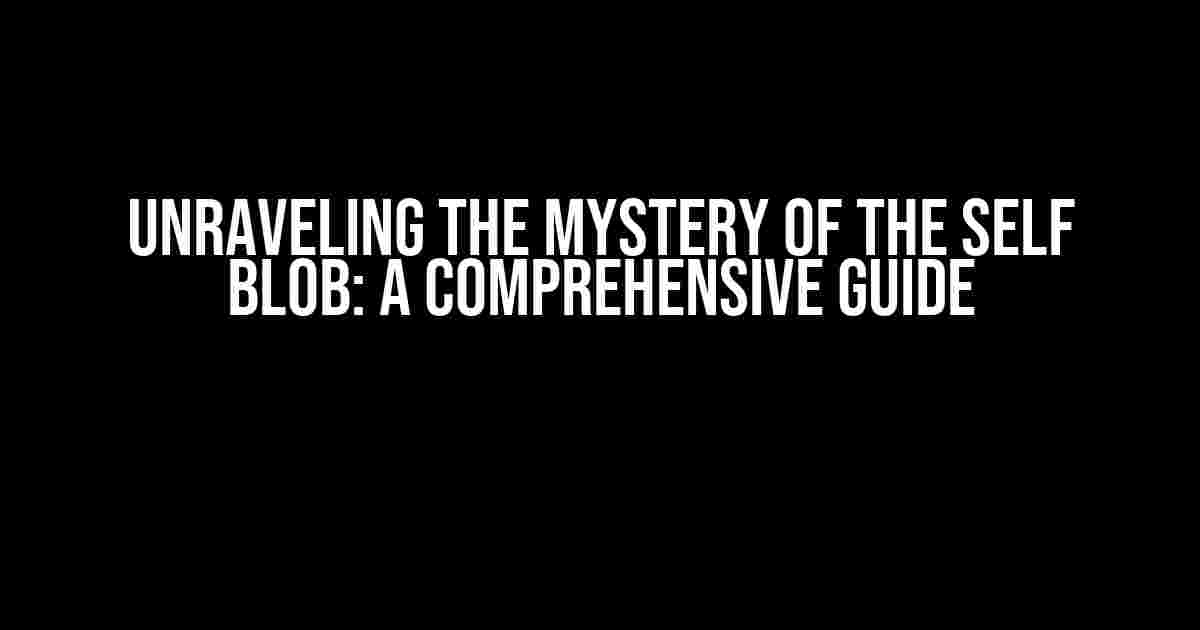Ah, the elusive concept of “self” blob. It’s a term that has been tossed around in developer circles, often leaving newcomers bewildered and scratching their heads. Fear not, dear reader, for today we embark on a journey to demystify the meaning of “self” blob and explore its significance in the world of programming.
What is the Meaning of ‘Self’ Blob?
At its core, “self” blob refers to an abstract concept in object-oriented programming (OOP) that represents an object’s reference to itself. Yes, you read that right – an object referencing itself! It’s a fundamental idea that enables objects to perform actions on themselves, making them more autonomous and self-aware (pun intended).
A Brief History of ‘Self’ Blob
The origins of “self” blob can be traced back to the early days of OOP. As developers began crafting more complex systems, they realized the need for objects to interact with themselves in a more meaningful way. This led to the introduction of the “self” keyword, which allows an object to refer to its own properties, methods, and behaviors.
How Does ‘Self’ Blob Work?
So, how does this mystical “self” blob come to life? Let’s dive into the nitty-gritty details!
Instance Variables and Methods
In OOP, every object has its own set of instance variables and methods. These are the attributes and behaviors that define the object’s characteristics and actions. The “self” keyword is used to access these instance variables and methods within the object itself.
class MyClass:
def __init__(self, name):
self.name = name # instance variable
def greet(self):
print(f"Hello, my name is {self.name}!") # accessing instance variable
In the example above, the “self” keyword is used to define an instance variable name and access it within the greet method.
Method Chaining and Fluent Interfaces
Method chaining is a technique where multiple methods are called on the same object in a single statement. Fluent interfaces, on the other hand, enable method chaining by returning the object instance itself. The “self” keyword plays a crucial role in making this possible.
class MyClass:
def method_a(self):
print("Method A called!")
return self # returns the object instance
def method_b(self):
print("Method B called!")
return self
obj = MyClass()
obj.method_a().method_b()
In this example, the “self” keyword is used to return the object instance, allowing method chaining to occur.
Real-World Applications of ‘Self’ Blob
Now that we’ve grasped the concept of “self” blob, let’s explore some practical scenarios where it shines:
Database Interactions
In database-driven applications, the “self” keyword can be used to perform CRUD (Create, Read, Update, Delete) operations on the object itself.
| Operation | Example |
|---|---|
| Create | self.save() |
| Read | self.get_data() |
| Update | self.update_attr(new_value) |
| Delete | self.delete() |
Event-Driven Programming
In event-driven programming, the “self” keyword can be used to register event listeners and handle events within the object itself.
class MyClass:
def __init__(self):
self.on_event = Event()
def register_listener(self, callback):
self.on_event += callback
def trigger_event(self):
self.on_event.trigger()
In this example, the “self” keyword is used to register an event listener and trigger an event within the object itself.
Common Pitfalls and Best Practices
As with any powerful concept, there are potential pitfalls to avoid when working with “self” blob:
- Avoid circular references**: Be cautious when using “self” in complex object graphs to avoid creating circular references, which can lead to memory leaks.
- Use “self” judiciously**: Only use “self” when necessary, as excessive use can make code harder to read and maintain.
- Document your code**: Clearly document your code to help others understand how “self” is being used.
By following these best practices, you’ll be well on your way to mastering the art of “self” blob!
Conclusion
In conclusion, the “self” blob is a fundamental concept in object-oriented programming that enables objects to interact with themselves in a meaningful way. By understanding how “self” works, you’ll unlock the doors to more robust, flexible, and maintainable code. Remember to use “self” judiciously, avoid common pitfalls, and document your code to ensure clarity and readability.
As you continue on your programming journey, keep in mind the wise words of Alan Kay, the father of OOP: “The purpose of a programming language is to make it easy to write programs that are easy to read.” By embracing the power of “self” blob, you’ll be well on your way to creating programs that are not only easy to read but also a joy to maintain!
- Further Reading: “Object-Oriented Programming: An Evolutionary Approach” by Brad J. Cox and Andrew J. Novobilski
- Recommended Resources: “Python Crash Course” by Eric Matthes, “JavaScript: The Definitive Guide” by David Flanagan
Frequently Asked Question
Ever wondered what the mysterious term “self” blob really means? Let’s dive into the world of self-discovery and find out!
What is the meaning of the “self” blob?
The “self” blob refers to the entirety of an individual’s being, encompassing their thoughts, emotions, experiences, and memories. It’s the unique, subjective essence that makes you, YOU!
Is the “self” blob a fixed entity?
Nope! The “self” blob is dynamic and ever-changing, influenced by your interactions with the world, personal growth, and experiences. It’s a continuous evolution of your identity!
How does the “self” blob relate to personal identity?
The “self” blob is the foundation of your personal identity, comprising your values, beliefs, and personality traits. It’s the core of who you are, shaping your relationships, decisions, and experiences!
Can the “self” blob be fragmented or split?
While the “self” blob is a cohesive entity, it can be influenced by different roles, personas, or emotions, creating a sense of fragmentation. However, at its core, the “self” blob remains a unified, integral part of your being!
How can I get to know my “self” blob better?
Engage in self-reflection, journaling, and mindfulness practices to tune into your thoughts, emotions, and desires. Embrace your curiosity and get comfortable with your own company – the better you know your “self” blob, the more authentic and fulfilled you’ll become!

